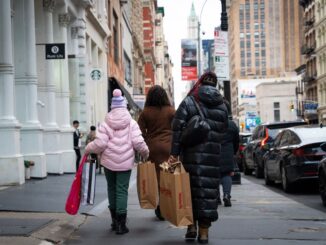
“A consumer slowdown is underway,” said Neil Saunders, managing director of analytics company GlobalData. “Growth is a lot more sluggish than it has been for quite some time and … retailers are reporting quite stark changes in consumer behavior.”
Executives at some of the country’s top retailers said this week that even higher-income consumers are reacting to persistent inflation, scaling back on big-ticket discretionary items and general merchandise.
One of the few winners this week was Walmart, which demonstrated it has scooped up and held onto new and younger shoppers looking for value. It reported Thursday that comparable U.S. store sales, a key metric, jumped 7.4 percent year-over-year — driven by increased spending in food, health and wellness categories — while e-commerce was up 27 percent, helped by new, higher-income shoppers taking advantage of pickup and delivery.
“We do see … higher purchase rates of categories like prime beef versus [regular] grade beef,” said John Furner, chief executive of Walmart U.S. “You see trade-ups … [in] apparel and marketplace. And that is definitely being driven by some of our newer higher-income customers.”
TJX, the parent company of TJ Maxx and Marshall’s, has also benefited from the shift. Same-store sales for the two brands grew 5 percent year-over-year, the company reported Wednesday.
The advantage of TJX is that “it’s on the right side of some of the consumer trend,” Saunders said. “People [are] seeking value, bargains, great deals in clothing to make their budgets … stretch further.”
In the case of Walmart, meanwhile, its strong grocery business is offsetting softer merchandise sales — indicating that its core customers are still cutting back in categories such as apparel, technology and furniture.
These trends were reflected in a report by the Census Bureau this week showing that retail sales inched up 0.4 percent in April from the previous month — half of what analysts expected. Spending on food, beverages, health and personal care was essentially flat once inflation — which rose 4.9 percent in April year-on-year — is factored in, Saunders said.
Sectors with weaker sales include apparel, home furnishings and sporting goods.
Those effects weighed on Target, which relies more heavily than Walmart on discretionary categories rather than basics like groceries. While total sales rose 0.5 percent in the first quarter compared to the same period last year, CEO Brian Cornell warned investors Wednesday that consumers are “becoming more cautious in their overall shopping behavior” and that discretionary category sales softened because of the “pressure from inflation and rising interest rates.”
Beauty, however, was a strong sector for the Minneapolis-based retailer. The company has broadened its offerings and partnered with Ulta Beauty to add high-end brands at Target stores.
“Beauty has continued to show strength — mass market as well as luxury,” said Mike Graziano, a consumer products analyst at the consulting firm RSM. “The adage is the ‘lipstick economy.’ You’re going to still spend some money on beauty products even when we’re in a downturn.”
Home Depot has also suffered from the consumer pullback. The Atlanta-based home improvement chain had already lowered its sales outlook this year, but its projections and revenue still missed the mark Tuesday when executives reported that sales declined 4.2 percent in the first quarter.
Sales of big-ticket discretionary items such as patio gear, grills and appliances slumped. Demand also waned across flooring, kitchen and bath, which “may reflect consumers moving away from larger to smaller projects,” Billy Bastek, its executive vice president of merchandising, told investors. The company also attributed shortfalls to falling lumber prices and unfavorable weather, particularly in California.
More broadly, the company warned, it expects annual sales to fall for the first time since 2009. Home Depot’s share price fell about 2 percent by market close on Tuesday.
The underlying challenge is that consumer confidence in the economy is weakening as inflation persists and fears grow over a debt ceiling crisis. The University of Michigan’s consumer sentiment index dropped almost six percentage points from April to May — an important indicator given that consumer spending accounts for two-thirds of the economy and people are more likely to spend if they feel economically stable.
Meanwhile, total consumer debt has hit a record $17 trillion in the first quarter this year, the New York Federal Reserve reported Monday. While credit card debt was roughly steady at $986 billion, it stood out because it usually declines in the first quarter.
Still, many consumers keep on spending — enough to keep company sales from falling dramatically. Simeon Siegel, an analyst with BMO Capital Markets, noted that while there are clear signs “the U.S. consumers’ health is deteriorating,” they have consistently demonstrated their ability to overspend.
“Recognizing that the environment is tougher than it was, we are still seeing people … spend on things they want if they are important to them and they need to be replenished,” Siegel said.
Source: www.washingtonpost.com
ENB
Sandstone Group





